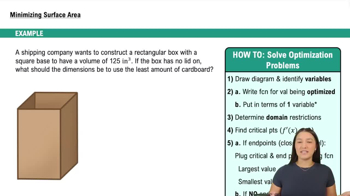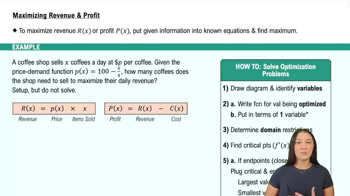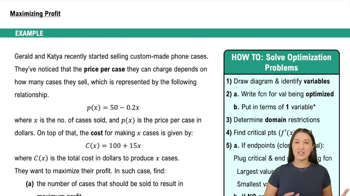Table of contents
- 0. Functions7h 52m
- Introduction to Functions16m
- Piecewise Functions10m
- Properties of Functions9m
- Common Functions1h 8m
- Transformations5m
- Combining Functions27m
- Exponent rules32m
- Exponential Functions28m
- Logarithmic Functions24m
- Properties of Logarithms34m
- Exponential & Logarithmic Equations35m
- Introduction to Trigonometric Functions38m
- Graphs of Trigonometric Functions44m
- Trigonometric Identities47m
- Inverse Trigonometric Functions48m
- 1. Limits and Continuity2h 2m
- 2. Intro to Derivatives1h 33m
- 3. Techniques of Differentiation3h 18m
- 4. Applications of Derivatives2h 38m
- 5. Graphical Applications of Derivatives6h 2m
- 6. Derivatives of Inverse, Exponential, & Logarithmic Functions2h 37m
- 7. Antiderivatives & Indefinite Integrals1h 26m
- 8. Definite Integrals3h 25m
5. Graphical Applications of Derivatives
Applied Optimization
Problem 4.5.33
Textbook Question
Maximum-volume cone A cone is constructed by cutting a sector from a circular sheet of metal with radius 20. The cut sheet is then folded up and welded (see figure). Find the radius and height of the cone with maximum volume that can be formed in this way. <IMAGE>
 Verified step by step guidance
Verified step by step guidance1
Let the angle of the sector be θ (in radians). The arc length of the sector will become the circumference of the base of the cone, which can be expressed as 20θ = 2πr, where r is the radius of the cone's base.
From the equation 20θ = 2πr, solve for r in terms of θ: r = (20θ)/(2π) = (10θ)/π.
The height h of the cone can be determined using the Pythagorean theorem. The slant height of the cone is the radius of the original circle (20), so h = √(20² - r²). Substitute r from the previous step into this equation.
The volume V of the cone can be expressed as V = (1/3)πr²h. Substitute the expressions for r and h in terms of θ into this volume formula.
To find the maximum volume, take the derivative of V with respect to θ, set the derivative equal to zero, and solve for θ. Then use this value to find the corresponding r and h.
Was this helpful?

 1:13m
1:13mWatch next
Master Intro to Applied Optimization: Maximizing Area with a bite sized video explanation from Callie
Start learningRelated Videos
Related Practice









